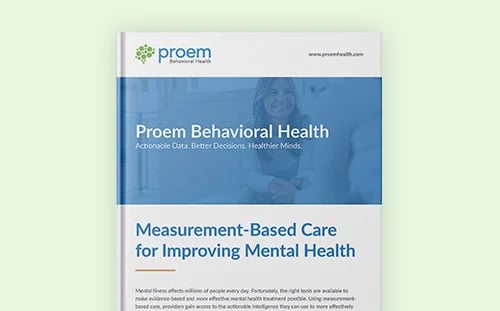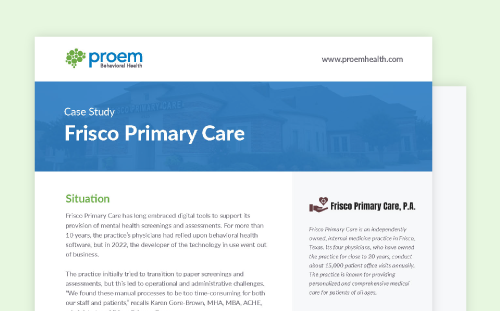
The links between poor physical and behavioral health are well documented. A report in World Psychiatry notes that patients with severe behavioral health disorders have a life expectancy up to 25 years shorter than the general population.
Though the reasons for this discrepancy are complex, the report suggests a lack of coordination among primary care and behavioral health providers often plays a key role. Simply put, behavioral health providers are ill-equipped to attend to the physical health of their patients, while primary care physicians have little insight into their patients’ behavioral health needs.
Within the last two decades, practitioners and policymakers alike have realized the benefits of integrated behavioral health care. Legislation such as the Affordable Care Act expanded insurance coverage for behavioral health services, and in 2018, Medicare began reimbursing primary care physicians (PCPs) for providing certain mental health services. Taken together, these initiatives point to an increased awareness that whole person care contributes to improved mental health outcomes and lower overall healthcare spending.
Defining Behavioral Health Integration (BHI)
Before jumping into the specifics of how integrating physical and behavioral health services can benefit providers and patients, it’s worth unpacking some of the nuances around terminology.
The federal Agency for Healthcare Research and Quality (AHRQ) frames integrated behavioral health as the practice of providing care for clinical and behavioral health in the same setting. Unless patients either request or require specialty services, integrated care teams deliver coordinated care in the primary care setting. In fact, the practice can also be referred to as primary care behavioral health.
Though closely related, behavioral health integration (BHI) more commonly refers to the type of care the Centers for Medicare & Medicaid Services (CMS) will reimburse PCPs for providing.
As outlined by the American Academy of Family Physicians, this care falls into two buckets. One is for general BHI services, which can include assessment and monitoring, care planning, and coordination of additional treatment. The other consists of a series of billing codes for Collaborative Care Management, which includes services provided by a psychiatrist or designated behavioral health care manager.
CMS initially introduced BHI billing codes in 2017 and revised them in 2018. A utilization analysis for that two-year period concluded PCPs and advanced care practitioners were the providers most likely to bill for the services, with mood disorders representing the most common diagnosis.
In response to demand for behavioral health services during the COVID-19 public health emergency, CMS further expanded BHI coding options. The American Psychological Association explains that as of 2023, care can now be provided under general supervision, meaning that a physician need not be present when counselors, family therapists, social workers or other licensed practitioners provide services.
Improving Mental Health Outcomes
Research has shown between 68% and 75% of patients with a diagnosed behavioral health condition also have at least one other medical condition. These figures are unfortunately only likely to increase, as McKinsey estimated the trauma of COVID-19 could ultimately lead more than 35 million Americans to experience heightened behavioral health needs. Failing to meet these needs will come with a staggering cost. The Primary Care Collective states that medical expenses for patients with chronic physical and behavioral diagnoses are 46% higher compared to patients with only a chronic medical condition.
Increasing access to care through practices such as primary care behavioral health or general supervision can make the benefits of integrated behavioral health care more readily available to patients in need. As AHRQ points out, integrating behavioral and clinical care offers a convenient form of “one-stop shopping,” allowing patients to receive care from multiple providers in a single, familiar setting.
Meeting patients where they are matters. A seminal New England Journal of Medicine paper found 67% of patients with behavioral health disorders don’t receive treatment, while 50% of those who do are treated in the primary care setting. The less time patients must spend waiting to schedule appointments or chasing referrals for behavioral health services, the more likely they are to receive treatment.
The integrated care model has additional benefits as well, including the following:
-
The National Alliance on Mental Illness (NAMI) notes that screening for behavioral health as part of routine primary care delivery helps identify symptoms earlier, leading to earlier interventions.
-
The stigma of receiving behavioral health treatment goes down. Patients are seen within primary care as part of a normal patient experience
-
Practitioners can coordinate the care they provide. For example, they can better understand and address the behavioral health factors that may cause a patient to struggle to manage diabetes or high blood pressure.
-
A roundup of research from the Primary Care Collaborative points to lower overall care costs when treating depression in primary care, both on its own and as a comorbidity. In addition, behavioral health treatment in primary care decreases overall utilization by 16% – compared to a 12% increase in patients with unaddressed behavioral health needs.
-
A physician survey published by Families, Systems & Health showed a satisfaction rate of more than 97% for integrated behavioral health programs, coupled with a 90% reduction in personal stress levels for PCPs participating in such programs.
Leveraging Technology to Promote Whole Person Care
The impact of unmet behavioral health needs is stark – a higher cost of care, a shorter life span and a lower quality of life. The health care industry is making a concerted effort to deliver better behavioral health by integrating it with primary care and increasing access to services to ensure more patients can realize the benefits of integrated behavioral health care. Meanwhile, policymakers have introduced and expanded behavioral health integration (BHI), allowing more practitioners to receive reimbursement for providing behavioral health services in a primary care setting.
Augmenting primary care with behavioral health is no small task, however. Inconsistent processes, complicated workflows, and a limited capacity for evaluation and follow-up can hinder efforts to provide whole person care and further frustrate practitioners. Practices need robust technology solutions capable of screening, treating and monitoring patients without introducing complexity or otherwise getting in the way of delivering cutting-edge care.
To find out more about how the Proem workflow solution can support the delivery of BHI, book a meeting.





.png)









